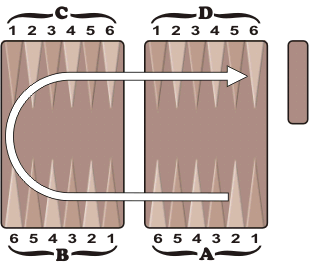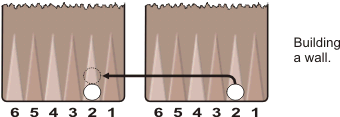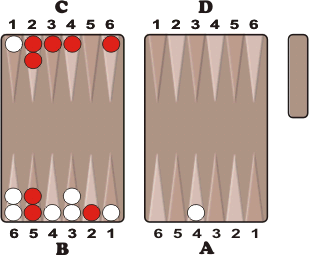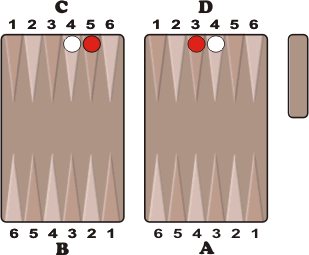![[Backgammon Galore!]](/gif/GaloreButton.gif)
|
|
Backgammon Variants Equipment: No dice are used in this game. Each player has fourteen checkers of his own color. (Beginners may prefer fewer checkers in their first games, but each player should start with an even number.) Setup: All checkers start off the board. Both players move in the same direction and bear off from the same quadrant (Quadrant D in the diagram below). Movement is from Quadrant A to B, from B to C, and from C to D.
Object of the game: To win the game, a player must score twice in succession, though not necessarily in two consecutive turns. A player scores by moving his checkers around to Quadrant D, building a wall as described below, and then bearing the wall off. To start: Flip a coin or roll dice to determine who goes first. The first player enters a checker onto any point in Quadrant A. Then the second player enters a checker onto any different point in Quadrant A. After the first two checkers have been entered, players have a choice of either entering more checkers onto vacant points in Quadrant A or moving a checker that is already on the board. Moving: A move consists of taking a single checker from any quadrant (except Quadrant D) and placing it on a vacant point in the next quadrant. For example, you can take a checker from Quadrant A and place it on any empty point in Quadrant B. Walls: A wall consists of two checkers of the same color residing on the same point. You may build a wall when you have two checkers exactly six points apart by moving the farther-back checker on top of the forward one.
Once a wall has been built, no single checker of either side may move across the wall. However, the top checker of a wall has particular freedom denied to single checkers: it may jump as many walls as there are in its way, provided that beyond them there is either a vacant point to land on or a single checker of the same color six points away on which to build a wall. In all other respects, the top checker of a wall is governed by the same rules as single checkers.
In the diagram above, the white checker on A4 cannot make a wall on B4 because the wall at B3 is in the way. In fact this checker cannot move at all because the other points in Quadrant B are already occupied. In the same diagram, the red checker on B5 can jump the walls at B6 and C2 to land at C5. There will be times when one player is unable to make any move at all. The other player continues to play until the immobilized player has an opportunity to move again. Bearing off: Once a checker reaches Quadrant D, it cannot move any further until a second checker of the same color joins it to form a wall. Then the whole wall can be borne off in one turn. Bearing off a wall scores a point. And if the player who last scored a point scores again, he wins the game. Occasionally, the last two checkers of one side are placed so they cannot build a wall in the final quadrant. For example, in the diagram below, Red has one checker on C5 and the other on D3.
If Red has no other move, he must move his checker on C5 to a vacant point in Quadrant D, then on his next turn take it off without scoring. Strategy: Grasshopper gives an equal chance to both players. Fast, isolated checkers running to the final quadrant are not effective. You should advance cautiously in small or large groups. The idea is to build a supply line by occupying the same numbers on several consecutive points. You cannot build walls in the first quadrant where you enter your checkers. But you can cut off the supply line of your opponent by occupying the point that leads to his wall. The player with the better supply lines usually wins.
References
|
![]()
Backgammon Galore : Variants




